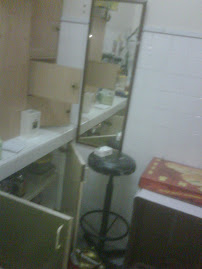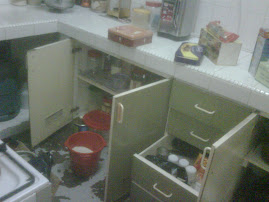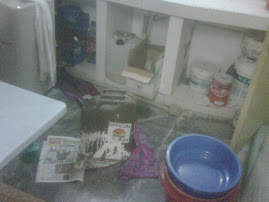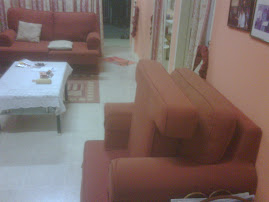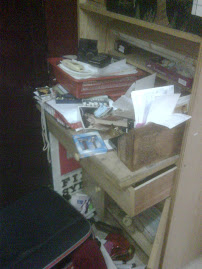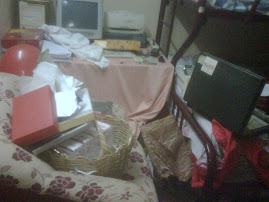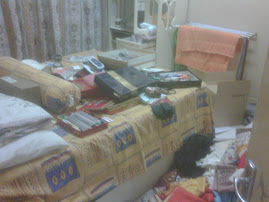Monday, August 16, 2010
50 REASONS WHY IT WILL BE DIFFICULT FOR BN TO SECURE A CONVINCING VICTORY
Wednesday, May 19, 2010
‘Project Sunshine’ changes life in the longhouse


A longhouse resident (pic above) making an international call from
The solar installation on the far right (pic below) on a hillock overlookingthe Kerapa Spak longhouse (left)
IBC COMPLETES SOLAR HYBRID SYSTEM IN
KERAPA SPAK, BETONG
The system dubbed SHS (solar hybrid system) was installed at a feverish pace over a period of four months by IBC Solar Teknik Sdn Bhd, the main contractors who are in a joint technical co-operation with Sarawak based Carbon Capital Corporation Sdn Bhd.
The German based technology, reputed to be the best technology in the solar industry was realised in Kerapa Spak at a cost of RM4.5 million – a cost which is protected by its quality and durability.
The IBC system complies with Europe’s IEC 616 standards wherein power output is guaranteed for 25 years – a definition which spells out the fact that capability does not drop more than 80 per cent failing which the supplier would have to replace the product.
These are the IEC standards upheld by IBC when they did their installation at Kerapa Spak which would have far–reaching effects on the capabilities of the longhouse folk in this particular locality.
The Chief Exectuive Officer of IBC Solar Teknik Ahmad Nazri Ibrahim said that in addition to the lighting -up of the longhouse, the surrounding area’s street lighting, the community area and church have also been lighted up.
“With power comes everything else and among the possibilities that have already made its mark is the pre-paid satellite uplinked telephony system,” he said.
“Longhouse folk are now practically queueing daily up to use the pay phone as they can call anywhere in the world and it will be a matter of time before they join the cyber world with internet access and broadband capabilities besides installing Astro TV.”
Nazri has his reasons for selecting Sarawak and as he puts it, “It is my conscientious belief that after more than 45 years of independence with Malaysia, our brother and sisters in the remote interiors of Sarawak and Sabah are somewhat detached and isolated from mainstream infrastructure development.”
“How are they to develop if they keep on living in such isolation occurring naturally or by design, I wonder.
“They still have no power, limited power in most places, no clean and piped water, no digital information super highway vide the internet and in my honest view, this is completely unacceptable if you see it against the background of a nation trying to scramble for a developed nation status.”
The installation at Kerapa Spak features the construction of a solar house, putting up of the solar modules, inverter, load and battery banks which take up to 40 per cent of the cost. Work was also hampered by the accessibility as most of the things had to be taken up river on five to six-hour longboat rides from Pengkalan in Betong.
The irony however was that despite this being a corporate social responsibility CSR) of IBC with absolutely no cost to the State or Federal governments, there was no other form assistance extended to them from agencies or even the Royal Malaysian Air Force (RMAF) which flatly refused to airlift the equipment citing cost as a reason. IBC had to resort to using costly private helicopter charters to airlift the heavy components.
There is no road access to this longhouse as everything is dependent on the river and the nightmarish work of bringing equipment up will long live in the memories of the team of engineers and technicians who put up installation together.
This added to other logistical frustrations which were encountered by the IBC team over the last four months specially in getting construction material organised in the thick of the jungles.
By no measure was it an easy task for IBC Solar from leveling a jungle clearing ona nearby hillock to forming a clearing and a helipad and making concrete bricks to name a few tasks that were achieved.
The solar hybrid system, according to Nazri is guaranteed to be safe with no possibility of its products either exploding or igniting a fire and with no moving parts, there is less maintenance, noise and above all being environment-friendly.
Being AC coupling in character, the system comprises a 70 per cent solar and a 30 per cent diesel generator back up and is designed to last for 25 years thus ensuring a clean and friendly environment.
IBC, said Nazri, would not be maintaining this CSR project but nevertheless he added, they were in talks with the State Government to appoint IBC Solar under a normal maintenance contract for a period of two years..
What used to be pitch darkness after diesel-powered generators are shut down to save on cost, is now a thing of the past in Kerapa Spak.
The second phase of this project shall witness the installation of dedicated power points for individual “pintu” which will enable longhouse folk to draw power for their individual household needs to run their hi-fis, refrigerators and other appliances.
“With this comes tapped clean and filtered drinking water with the installation of a membrane pump system powered by the solar hybrid system. A longhouse with power, communication and clean water completes the agenda providing the basic amenities and providing the longhouse folk an opportunity to move forward and engage themselves and their lifestyles in the mainstream of development,” said Ahmad Nazri.
IBC represents one of the best German-based technology partners in the form of IBC Solar AG which boasts the most advanced technology and products besides being the initiator of solar technology and currently spearheading the industry.
In the Kerapa Spak project IBC functions as the main contractor on top of being the system designer and integrator. The peninsular based company is in a joint technical co-operation with Kuching-based Carbon Capital Corporation (CCC) Sdn BHd. The project also involved a telecommunications component which witnessed the active participation of Paycomm Sdn Bhd.
Nazri feels that Project Sunshine would aptly describe what’s happening in Kerapa Spak in the rural electrification scheme (RES) of things.
The Kerapa Spak longhouse was selected by Sarawak Chief Minister Pehin Sri Haji Abdul Taib Mahmud as part of his overall vision to provide cheap and versatile electricity to pockets of settlements in longhouses and villages in the remote interiors of the state.
“Electricity is synonymous with the quality of life, security and growth and a good infrastructure, reliable power generation and independence from raw material imports are all essential for prosperity and satisfaction,” said Ahmad Nazri.
“Kerapa Spak is in that position and is now demonstrating this
“It will be a far cry from the manner in which the Iban longhouse community conducted their lives before.”
The investment, Ahmad Nazri feels, would go a long way in proving that for one the public and private sector can engage by way of policy. This he added comes in tandem with the government’s call for greater policy engagement between the two sectors in working together for the benefit of the people.
This project comes as one of the company’s major corporate social responsibility (CSR) initiatives in Sarawak.
The most noteworthy feature of this solar hybrid system is that in essence, it can not only supply electricity but also support water supply, power up systems for healthcare, ensure security with telecommunications link ups, tourism activities, education and cottage industries in the future.
Ahmad Nazri said the SHS under normal circumstances would require between three to four months to install making it one of the fastest solar applications readily available in the market as proven by the project in Kerapa Spak.
IBC Solar Teknik’s role as a systems integrator, is actually appropriately positioned to customise and tailor-make installations to suit each and every location and their respective peculiarities. This is evidenced in Project Sunshine which has taken shape in Kerapa Spak.
The solar modules and the solar house
A close-up of the solar modules which are powering up the Kerapa Spak longhouse.
Longhouse folk in the ruai area of the longhouse with the lights already switched on in the evening.
The site of the solar and solar modules when construction began four months ago.
Construction material at site when work commenced in November 2009
River bed rocks practically carried up from using boats and manpower in gunny sacks to form the bedding base for the solar modules.
The site in March 2010
A helicopter used to bring up the heavy equipment about to land in a clearing made as a helipad
next to the solar house and modules.
Equipment practically made it by air from German and Kuala Lumpur to Kuching and then by road to Betong and on loangboats to Kerapa Spak.
Netting being prepared to airlift the battery banks by private helicopter charter from Betong to Kerapak Spak
An aerial view of the IBC solar installation (right) and the Kerapa Spak longhouse on the left.
The Kerapa Spak longhouse lighted up at nightwith solar power.
Monday, April 19, 2010
Journey upriver to Kerapa Spak
1. Breakfast in Betong town, four hours by road from Kuching city. This town only wakes up at about 7am or so.
2. This location is Pengkala Kerapa on the Nanga Spak. We board the longboat from this point some 40 minutes from Betong town. The boat ride can cost anything from RM380 to RM600 one way.
3. The journey is about to begin. Our destination is Kerapa Spak longhouse. The journey is expected to take about four to five hours.
4. The longboat can seat a maximum of six persons excluding the boatman who steers the outboard engine from the rear and his navigator who sits right up front.

5.The journey is quite smooth sailing except for very shallow stretches where the boatman has to get off and push the boat through and at stretches where he has to force his boat through resuolting in snapping his propellers. They come prepared to change parts along the way.
7. You might have to get down help push the boat across some really shallow patches along the way.
9. At the longhouse in Kerapa Spak.. after five hours.
Project Sunshine nears completion
The Kerapak Spak longhouse community of some 500 Iban folk nestled in the Betong Dvision of Sarawak, will soon become a centre of attraction when IBC Solar Teknik Sdn Bhd is done installing their Solar Hybrid System which is expected to provide long awaited electricity supply, drinking water and a telecommunications link. This project is being donated by IBC Solar as part of their corporate social responsibility inspired by the call made by Sarawak Chief Minister Pehin Sri Haji Abdul Taib Mahmud in extending rural electrification to the interiors. The project is valued at one million euros (RM4.5 million). Work on this project which began in November last year is expected to be completed next month. The longhouse is now seen in clear view of the solar house which is already up with other works progressing full steam ahead. The project is currently about 85 per cent complete and is expected to be handed over in mid May by the Prime Minister Datuk Seri Najib Tun Razak.
LAWLESSNESS IN MALAYSIA
When driving in the roads and streets of downtown Kuala Lumpur, you have to get used to this sort of crappy driving by Rapid KL buses. What's the point having expensive buses dirven by morons who are ignorant of simple road discipline. They appear to make everyone in the bus a stupid lot having to tolerant such nonsense by the driver. To RAPID KL and Prasarana... the bus service is akin to the days of teh hell driving mini-buses. We haven't learnt and we haven't improved. Low class public transportation behaviour, I must say.

Sunday, April 18, 2010
Project Sunshine tipped to change life in the longhouse


IBC’S SOLAR HYBRID SYSTEM MAKES IT TO KERAPA SPAK, BETONG
KUCHING (March 24, 2010): Life will not be the same for the Iban community of 500 folks staying in an isolated longhouse nestled in the interiors of Sarawak Betong Division as they will be the fortunate ones to enjoy a solar hybrid system.
The system dubbed SHS is being installed at a feverish pace at the longhouse by IBC Solar Teknik Sdn Bhd the main contractors of what is a reputed the first of its kind undertaking to provide not only cheap, lasting and versatile supply of electricity but with it comes clean drinking water and a telecommunications uplink which will see the onset of internet and cable TV making its way into the 43 ‘pintu’ or doors of this longhouse.
What used to be pitch darkness after diesel-powered generators are shut down to save on cost will soon not only be a night of brightness but complete with hi-fi music, Astro TV, internet surfing and phone calls to any part of the world. Tapped drinking water too coming with these, makes the SHS a flagship undertaking which would be very much in line with the government’s move to expand rural electrification to the hard interiors of Sarawak.
IBC represents one of the best German-based technology partners in the form of IBC Solar AG which boasts the most advanced technology and products besides being the initiator of solar technology and currently spearheading the industry.
In the Kerapa Spak project functions as the main contractor besides being the system designer and integrator as it also involves a telecommunications component that sees the participation of Paycomm Sdn Bhd.
IBS Solar Teknik’s Chief Executive Officer Ahmad Nazri Ibrahim feels that Project Sunshine would aptly describe what’s happening in Kerapa Spak in the rural electrification scheme.
The Kerapa Spak longhouse was selected by Sarawak Chief Minister Pehin Sri Haji Abdul Taib Mahmud as part of his overall vision to provide cheap and versatile electricity to pockets of settlements in longhouses and villages in the remote interiors of the state.
Illustrating the nature in which the solar hybrid system would be working, Nazri explained that the DC current generated by the solar modules would either be used immediately for water pump systems, general lighting, telecommunications and for use by appliances or it would be stored in batteries.
“Electricity is synonymous with the quality of life, security and growth and a good infrastructure, reliable power generation and independence from raw material imports are all essential for prosperity and satisfaction, says Nazri.
“Kerapa Spak would be in the best position to demonstrate this once the installation is complete towards the later part of April, this year.
“It will be a far from the manner in which the Iban longhouse community conduct their lives today.”
The project estimated is going to cost IBC Solar Teknik a whopping RM4.5 million (one million euros). To this, NAzri quipped, “We have to break the egg’s shell first in order to eat it. SO how can we be sorry for breaking the shell.” The company has to date spent RM3 million securing 70 per cent progress in its works.
It has also not been for the working crew of IBC at Kerapa Spak. The longhouse folk, he said had been quite helpful and we have engaged them in toto to perform a major part of the construction work .
All material, he added, had to be brought in through a treacherous six-hour long boat ride from Pengkalan near Betong which is a four-hour drive from Kuching. This included sand, stones, gravel and timber in addition to the hardware. Work at kerapa Spak started in November 2009 following a memorandum of understanding between the State Ministry of Public Utilities and Carbon Capital Corporation (CCC) to carry out solar hybrid projects in the state in June last year. CCC is working in collaboration with IBC Solar Teknik as the main contractor of the former.
Other logistical support comes airlifts provided by the Royal Malaysian Air Force (RMAF) based in Kuching.
The investment, Nazri feels would go a long way in proving that for one the public and private sector can engage by way of policy. This he added comes in tandem with the government’s call for greater policy engagement between the two sectors in working together for the benefit of the rakyat.
This project comes as one of the company’s major corporate social responsibility (CSR) initiatives in Sarawak.
The most noteworthy feature of this solar hybrid system is that in essence it can besides supplying electricity, also support water supply, power up systems for health care, ensure security with telecommunications link ups, tourism activities, education and cottage industries.
Nazri said that the SHS under normal circumstances would require between three to four months to install making it one of the fastest solar applications readily available in the market and IBS Solar Teknik’s role as a systems integrator, is actually appropriately positioned to customise andtailor-make installations to suit each and every location and their respective peculiarities. This is evidenced in Project Sunshine taking shape in Kerapa Spak.
Thursday, March 11, 2010
Placing the chip in the right place to spur New Economic Model

MALAYSIA has all it takes to make that quantum leap into becoming a high-income nation. The New Economic Model (NEM) will be a monumental task for Malaysia in steering its workforce in the direction most desired in achieving such an economic model.
But is the government prepared to make a departure from its conventional approach of having to rely quite heavily on foreign experts to consult for work to be done.
Do we not have what it takes to provide such expertise and do we not have what it takes to carry from where many had left.
The NEM to be proposed by the Prime Minister Datuk Seri Najib Tun Razak towards the end of this month will focus on raising the productivity level of workers and helping them earn higher income.
This task is expected to be handled by a new economic council comprising experts both from within Malaysia as well as from aboard.
The model would undoubtedly outline how Malaysia is going to improve its economic situation from the high middle income level where it is positioned currently to a high income level.
The quantum leap desired by way of increase in workers’ productivity should not only be more hours worked but it also has to harness innovation and creativity.
By achieving this, the workforce will be paid higher salaries. With the NEM in place, all efforts be they those involving the private sector, government-linked companies (GLCs) or even government companies can in a parallel move, raise workers’ skills through such innovation and creativity to ultimately bring progress to the nation.
The NEM therefore has to be carved, chipped, smoothened and scupltured in such a way so that it can be beneficial to workers within the country being able to attain a higher level of competitiveness.
The government's goal is to enable the country to make a quantum leap and efforts must be taken to translate the noble desire of the government to translate such efforts into a reality.
The current rate of unemployment in the country is about 3.1 percent in 2009 and could increase to four per cent this year due to impact of the global economic recession, a situation which has to be addressed as the NEM is being formulated so that the jobless are employed and the rate of unemployment kept in check.
The NEM would indeed have to lay the groundwork now to develop the required pool of talent ready to take on such a big challenge.
SKALI’s contribution as a major player in the MultiMedia Super Corridor (MSC) for one, thus far has seen the company creating job opportunities and technopreneurs via the execution of the managed portal services (MPS) project.
Timely too is the 1Malaysia concept launched by the Prime Minister which is expected to draw on the strengths of a united population with leaders seeing and visualising this together.
A campaign of this magnitude requires strength in unity, selfless hardwork and the magnanimity of helping others to come onboard and be engaged in the process of change and transformation.
But in order for the policy to gain ground, there will be need for a wider participation and engagement by captains of industry and political leaders alike to be in sync with the Prime Minister in wanting to move this forward.
But not forgoing the fact that these are transformations being attempted during trying times of a global economic recession and countries such as Japan and The Netherlands in fine tuning their policy moves and practices should lend us a hand in taking the cue to better protect ourselves from volatility.
A common group is therefore sought where they can work together in overcoming obstacles and facing up to challenges which they might encounter in its implementation.
Before one knows it, the decade will be up and we are staring 2020 right in the eye and expect the middle spectrum of the visionary management spelt out by its conceptualiser to materialise and unfold Malaysia as a newly developed nation carrying a label that has to read “yes we can.”
The catch phrase could have worked wonders for Barrack Obama in his socio-political economic reform of the United States but it had better not be a phrase which we find difficult to live up to if old mindsets are not changed.
There is no room and there will be no patience in tolerating those out to make a quick buck for themselves by taking advantage of the privileges that are expected to be handed out as the NEM takes shape.
There will also be no slowing down in dealing with petty and trivial issues that could crop up along the way as the mode of engagement would be look at the bigger picture and be involved in the macro-economics of such governance.
Encouraging and promoting local business talent from whom a number of them had even broken barriers and taken that Malaysian brand name across the globe.
When such business icons are unearthed, Malaysia will emerge in a new dimension of being an an active seller as opposed to being a tradional buyer in the past. Names in the league of Air Asia, Maxis, Axiata, Sime Darby, Astro, YTL to name a few have forced decision makers to sit up and take notice that going Malaysian is by all means being Malaysian and warrants recognition from the government especially in having to be assigned such tasks.
To develop such icons, the government needs to provide them a platform so that they are able innovate their business ventures and take them to the next level by providing incentives and the marketing needed to accelerate their growth to achieve the desired results.
The government too needs to break away from its conventional modus operandi of mostly engaging with foreign consultants to undertake jobs which could otherwise be handled by homegrown Malaysian expertise and talent.
If such opportunities are not given to locals, they will never be tried and tested to emerge as lead players in critical areas of development projects.
The underlying message would be of course to tap on local talent and given them an active role to play in the NEM and by 2020, Malaysian professionals in their late 20s would be in their fourties with the right maturity and experience to become active players and take over agencies to administer and manage them more effectively with new management modes and techniques of changing times.
Skali has managed to do this over the years and have fully harnessed the talent inherent in fresh local graduates who were made to be involved in the management of portal services given their disciplines in the fields of information and creative technology.
However, the success of the NEM given the current scenario will only be able to germinate if it is led professionally and enriched with the concerted efforts of those entrusted to play a vital role in its implementation.

















.jpg)
.jpg)

